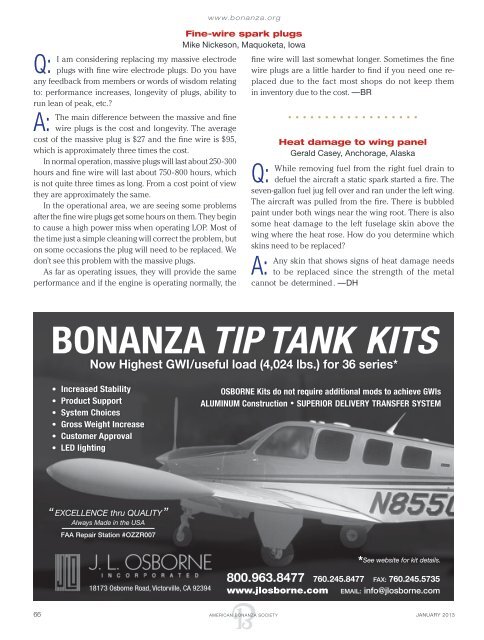Insurance Discount May Pay for Your BPPP Training - American ...
Insurance Discount May Pay for Your BPPP Training - American ...
Insurance Discount May Pay for Your BPPP Training - American ...
Create successful ePaper yourself
Turn your PDF publications into a flip-book with our unique Google optimized e-Paper software.
Q:<br />
I am considering replacing my massive electrode<br />
plugs with fine wire electrode plugs. Do you have<br />
any feedback from members or words of wisdom relating<br />
to: per<strong>for</strong>mance increases, longevity of plugs, ability to<br />
run lean of peak, etc.?<br />
A:<br />
The main difference between the massive and fine<br />
wire plugs is the cost and longevity. The average<br />
cost of the massive plug is $27 and the fine wire is $95,<br />
which is approximately three times the cost.<br />
In normal operation, massive plugs will last about 250 - 300<br />
hours and fine wire will last about 750 - 800 hours, which<br />
is not quite three times as long. From a cost point of view<br />
they are approximately the same.<br />
In the operational area, we are seeing some problems<br />
after the fine wire plugs get some hours on them. They begin<br />
to cause a high power miss when operating LOP. Most of<br />
the time just a simple cleaning will correct the problem, but<br />
on some occasions the plug will need to be replaced. We<br />
don’t see this problem with the massive plugs.<br />
As far as operating issues, they will provide the same<br />
per<strong>for</strong>mance and if the engine is operating normally, the<br />
www.bonanza.org<br />
Fine-wire spark plugs<br />
Mike Nickeson, Maquoketa, Iowa<br />
fine wire will last somewhat longer. Sometimes the fine<br />
wire plugs are a little harder to find if you need one replaced<br />
due to the fact most shops do not keep them<br />
in inventory due to the cost. —BR<br />
Q:<br />
Heat damage to wing panel<br />
Gerald Casey, Anchorage, Alaska<br />
While removing fuel from the right fuel drain to<br />
defuel the aircraft a static spark started a fire. The<br />
seven-gallon fuel jug fell over and ran under the left wing.<br />
The aircraft was pulled from the fire. There is bubbled<br />
paint under both wings near the wing root. There is also<br />
some heat damage to the left fuselage skin above the<br />
wing where the heat rose. How do you determine which<br />
skins need to be replaced?<br />
A:<br />
Any skin that shows signs of heat damage needs<br />
to be replaced since the strength of the metal<br />
cannot be determined . —DH<br />
BONANZA TIP TANK KITS<br />
Now Highest gwi/useful load (4,024 lbs.) <strong>for</strong> 36 series*<br />
• Increased Stability<br />
• Product Support<br />
• System Choices<br />
• Gross Weight Increase<br />
• Customer Approval<br />
• LED lighting<br />
OSBORNE Kits do not require additional mods to achieve GWIs<br />
ALUMINUM Construction • SUPERIOR DELIVERY TRANSFER SYSTEM<br />
“ EXCELLENCE thru QUALITY”<br />
Always Made in the USA<br />
FAA Repair Station #OZZR007<br />
* See website <strong>for</strong> kit details.<br />
18173 Osborne Road, Victorville, CA 92394<br />
800.963.8477 760.245.8477 Fax: 760.245.5735<br />
www.jlosborne.com email: info@jlosborne.com<br />
66 AMERICAN BONANZA SOCIETY JANUARY 2013

















